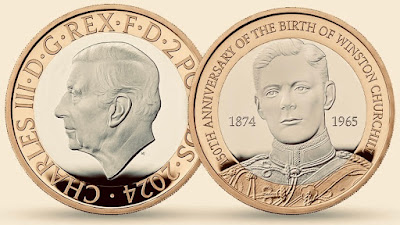Closing out the month of January is news from the Royal Mint. This has nothing to do with Freemasonry, except it concerns the memory of a famous Mason. The Royal Mint is releasing a £2 coin with the likeness of a young Winston Churchill on the reverse.
King Charles III’s profile graces the obverse. (I think they could have made an exception in this case, but this is not the first coin that depicts Churchill—he adorned the reverse of the 1965 crown after his death—so I’ll let it slide.) The fifty-ninth anniversary of Churchill’s death passed last Wednesday, but this coin is to commemorate the 150th birthday of the “greatest Briton,” which comes November 30. From the publicity:
Sir Winston Churchill:
An Inspirational Leader
Marking the 150th Anniversary
of the Birth
of Sir Winston Churchill.
Most famous for leading Britain to victory in the Second World War, Sir Winston Churchill was a statesman, writer, orator and leader who became one of the most influential prime ministers in British history.
Born in Blenheim Palace in Oxfordshire on 30 November 1874, Churchill developed a fascination with the military from an early age and joined the cavalry in 1895, serving in the 4th (Queen’s Own) Hussars. His service in the military took him all over the world to countries such as Cuba, Afghanistan, Egypt and South Africa, where he simultaneously served as a part-time journalist.
Churchill’s political career began in 1900 when he was elected Conservative MP for Oldham. He defected to the Liberal Party in 1904, holding a number of Cabinet positions, before returning to the Conservative Party in 1924, serving as Chancellor of the Exchequer.
In the wake of Neville Chamberlain’s resignation in 1940, Churchill succeeded him as the prime minister of an all-party coalition government. His leadership during the Second World War was vital for Britain and it was during this time he gave some of his most famous speeches, which helped galvanise the nation during a time of great hardship.
Paying Tribute to an Influential Leader
 |
| © The Broadwater Collection |
Created by Natasha Seaward, a graphic designer at The Royal Mint, the Sir Winston Churchill coin features a portrait of Churchill as a young man in 1895, garbed in the uniform of the 4th Queen’s Own Hussars. In tribute to this anniversary, the coin’s legend reads ‘150TH ANNIVERSARY OF THE BIRTH OF WINSTON CHURCHILL,’ whilst the date of his birth and passing are displayed in equal prominence either side of the portrait. The edge inscription, ‘PAVE THE WAY FOR PEACE AND FREEDOM,’ is taken from a remark Churchill made in late 1953, whilst serving his second term as prime minister.
“Sir Winston Churchill is arguably one of the most influential prime ministers in British history; it is a privilege to have been selected to design a coin in his honour,” said Seaward. “Although rare for a statesperson, Winston Churchill has featured on UK coins several times before. Whilst he was well known for his influential speeches and his leadership during the Second World War, Churchill achieved many things prior to his time as prime minister that aren’t widely acknowledged. I wanted to portray a side of him less known to the public and therefore chose a portrait from his time serving in the 4th Queen’s Own Hussars.”
The Sir Winston Churchill 2024 UK £2 coin will be available as part of the 2024 Annual Sets and may also feature in other sets and product formats in the future.
Marking the Birth
of Sir Winston Churchill
Sir Winston Churchill is one of the most recognizable figures in British history and famously led Britain to victory in the Second World War. Born in 1874 at Blenheim Palace in Oxfordshire, he was the eldest child of Conservative politician Lord Randolph Henry Spencer-Churchill and American-born British socialite Jennie Jerome.
Churchill successfully passed the entrance examination to the Royal Military College Sandhurst on his third attempt and passed out as twentieth in a class of 130. His father passed away in 1895, which had a profound effect on the young Churchill as he entered the fourth Hussars in the same year.
Churchill’s career in the military saw him travel widely and would often write about the conflicts he encountered for newspapers. In 1900, Churchill turned his attention to politics and went on to have an impressive political career, representing five constituencies, serving under 13 prime ministers and becoming prime minister himself in 1940 and again in 1951. Two years later, in 1953, he received and accepted both the Order of the Garter and the Nobel Prize for Literature. The Sir Winston Churchill 2024 UK £2 coin will be available as part of the 2024 Annual Sets and may also feature in other sets and product formats in the future.
Click here to read the specifications of this coin. If I understand correctly, it will not be available for sale individually in either proof or uncirculated condition, but it could go into circulation if there is a demand. The coin is being made available, in proof and uncirculated, as part of these sets.
 |
| Art Daily |
Bro. Churchill was initiated into Studholme Lodge 1591 (now United Studholme Alliance Lodge 1591) on May 24, 1901. He was passed to the second degree July 19, and was raised a Master Mason on March 5, 1902.
And Studholme 1591 was consecrated on this date in 1876!
I really don’t know about his Masonic life. I always assumed he joined a lodge because that was something politicians did. To my knowledge, he did not work his way to the East, did not hold Grand Rank; or was inducted into any of the Orders beyond the Craft. I don’t know how long his membership in good standing at Studholme 1591 lasted.
Perhaps these are things to research for his sesquicentennial birthday this fall.
































